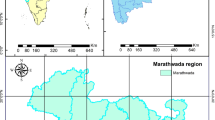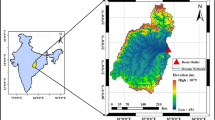Abstract
Droughts cause severe damage to the economy, society, and environment. Drought forecasting plays an important role in establishing mitigation drought damage plans. In this study, a hybrid model involving long short-term memory and a climate model (LSTM-CM) is constructed for drought prediction. LSTM-CM was compared to the long short-term model stand-alone (LSTM-SA) and climate prediction model GloSea5 (GS5). The performance of models was evaluated based on the Pearson correlation coefficient (CC), mean absolute error (MAE), root mean squared error (RMSE), and skill score (SS). GS5 displayed physical robustness in predictions and did not reduce the amplitude or shift results. However, GS5 prediction tends to have a large bias caused by the inputs, model structure, and parameters. The MAEs of GS5 at 1, 2 and 3 months (0.41, 0.68, and 0.89) were higher than those of LSTM-SA (0.38, 0.61, and 0.89). The LSTM-SA reduced bias, but predictions were characterized by shifts, small variance, and failure to capture drought occurrences in long-lead-time cases. LSTM-CM yielded enhanced drought predictions by encompassing the low bias of LSTM-SA and the physical process simulation ability of GS5; thus, it inherited the good features of these models and limited the poor features. The SS values based on the CC, MAE, and RMSE of LSTM-CM compared to those of GS5 for 1-, 2-, and 3-month lead time predictions were improved from 29.17 to 54.29, 22.47 to 34.15, and 1.75 to 35.09%, respectively. LSTM-CM can accurately detect drought events and displayed less uncertainty in prediction than LSTM-SA and GS5.








Similar content being viewed by others
References
Abrahart RJ, See LM, Solomatine DP (2008) Practical hydroinformatics: computational intelligence and technological developments in water applications. Springer Science & Business Media, Berlin, Heidelberg
Achite M, Banadkooki FB, Ehteram M et al (2022) Exploring Bayesian model averaging with multiple ANNs for meteorological drought forecasts. Stoch Environ Res Risk Assess 36:1835–1860. https://doi.org/10.1007/s00477-021-02150-6
Anshuka A, Chandra R, Buzacott AJV et al (2022) Spatio temporal hydrological extreme forecasting framework using LSTM deep learning model. Stoch Environ Res RISK Assess. https://doi.org/10.1007/s00477-022-02204-3
Bae DH, Rahman M, Koike T, Ahmad B (2013) Climate change impact assessment on the Asia-Pacific water resources under AWCI/GEOSS. Final Report of the APN ARCP Project: ARCP2011-05CMY-Bae, Asia-Pacific Network for Global Change Research
Banadkooki FB, Singh VP, Ehteram M (2021) Multi-timescale drought prediction using new hybrid artificial neural network models. Nat Hazards 106:2461–2478. https://doi.org/10.1007/s11069-021-04550-x
Bowman AW, Azzalini A (1997) Applied smoothing techniques for data analysis: the kernel approach with S-plus illustrations. OUP Oxford, Oxford
Danandeh Mehr A, Rikhtehgar Ghiasi A, Yaseen ZM et al (2022) A novel intelligent deep learning predictive model for meteorological drought forecasting. J Ambient Intell Humaniz Comput. https://doi.org/10.1007/s12652-022-03701-7
Daneshmand F, Karimi A, Nikoo MR et al (2014) Mitigating socio-economic-environmental impacts during drought periods by optimizing the conjunctive management of water resources. Water Resour Manag 28:1517–1529
Deo RC, Şahin M (2015) Application of the extreme learning machine algorithm for the prediction of monthly effective drought Index in eastern Australia. Atmos Res 153:512–525. https://doi.org/10.1016/j.atmosres.2014.10.016
Dikshit A, Pradhan B, Huete A (2021) An improved SPEI drought forecasting approach using the long short-term memory neural network. J Environ Manag 283:111979. https://doi.org/10.1016/j.jenvman.2021.111979
Essam Y, Ahmed AN, Ramli R et al (2022) Investigating photovoltaic solar power output forecasting using machine learning algorithms. Eng Appl Comput Fluid Mech 16:2002–2034. https://doi.org/10.1080/19942060.2022.2126528
Feng P, Wang B, Liu DL et al (2020) Dynamic wheat yield forecasts are improved by a hybrid approach using a biophysical model and machine learning technique. Agric for Meteorol 285–286:107922. https://doi.org/10.1016/j.agrformet.2020.107922
Gers FA, Schmidhuber J, Cummins F (2000) Learning to forget: continual prediction with LSTM. Neural Comput 12:2451–2471
Gibson PB, Chapman WE, Altinok A et al (2021) Training machine learning models on climate model output yields skillful interpretable seasonal precipitation forecasts. Commun Earth Environ. https://doi.org/10.1038/s43247-021-00225-4
Gorgij AD, Alizamir M, Kisi O, Elshafie A (2022) Drought modelling by standard precipitation index (SPI) in a semi-arid climate using deep learning method: long short-term memory. Neural Comput Appl 34:2425–2442. https://doi.org/10.1007/s00521-021-06505-6
Guerrero-Salazar PLA, Yevjevich VM (1975) Analysis of drought characteristics by the theory of runs. Hydrol Pap (Colorado State Univ no 80)
Hao Z, Singh VP, Xia Y (2018) Seasonal drought prediction: advances, challenges, and future prospects. Rev Geophys 56:108–141. https://doi.org/10.1002/2016RG000549
Hochreiter S, Schmidhuber J (1997) Long short-term memory. Neural Comput 9(8):1735–1780
Huang S, Huang Q, Chang J, Leng G (2016) Linkages between hydrological drought, climate indices and human activities: a case study in the Columbia River basin. Int J Climatol 36:280–290
Jehanzaib M, Idrees MB, Kim D, Kim T-W (2021) Comprehensive evaluation of machine learning techniques for hydrological drought forecasting. J Irrig Drain Eng 147:4021022. https://doi.org/10.1061/(ASCE)IR.1943-4774.0001575
Kang H, Sridhar V (2018) Improved drought prediction using near real-time climate forecasts and simulated hydrologic conditions. Sustainability 10:1799
Kim S-H, Lee M-H, Bae D-H (2016) Estimation and assessment of natural drought index using principal component analysis. J Korea Water Resour Assoc 49:565–577
Kim K-S, Lee J-B, Roh M-I et al (2020) Prediction of ocean weather based on denoising autoencoder and convolutional LSTM. J Mar Sci Eng 8:805. https://doi.org/10.3390/jmse8100805
Klemeš V (2019) Drought prediction: a hydrological perspective. In: Wilhite D, Easterling W, Wood D, Rasmusson E (eds) Planning for drought, 1st edn. Routledge, New York, pp 81–94
Krishnadas M, Sankaran M, Page N et al (2021) Seasonal drought regulates species distributions and assembly of tree communities across a tropical wet forest region. Glob Ecol Biogeogr 30:1847–1862. https://doi.org/10.1111/geb.13350
Lees T, Tseng G, Atzberger C et al (2022) Deep learning for vegetation health forecasting: a case study in Kenya. Remote Sens. https://doi.org/10.3390/rs14030698
Li J, Wang Z, Wu X et al (2021) Robust meteorological drought prediction using antecedent SST fluctuations and machine learning. Water Resour Res 57:e2020WR029413. https://doi.org/10.1029/2020WR029413
Liang X (1994) A simple hydrologically based model of land-surface water and energy fluxes for general-circulation models. J Geophys Res 99(D7):14415–14428
Lim J-Y, Kim S, Kim H-K, Kim Y-K (2022) Long short-term memory (LSTM)-based wind speed prediction during a typhoon for bridge traffic control. J Wind Eng Ind Aerodyn 220:104788. https://doi.org/10.1016/j.jweia.2021.104788
Mackay JD, Jackson CR, Brookshaw A et al (2015) Seasonal forecasting of groundwater levels in principal aquifers of the United Kingdom. J Hydrol 530:815–828. https://doi.org/10.1016/j.jhydrol.2015.10.018
MacLachlan C, Arribas A, Peterson KA et al (2015) Global Seasonal forecast system version 5 (GloSea5): a high-resolution seasonal forecast system. Q J R Meteorol Soc 141:1072–1084
Madadgar S, AghaKouchak A, Shukla S et al (2016) A hybrid statistical-dynamical framework for meteorological drought prediction: application to the southwestern United States. Water Resour Res 52:5095–5110. https://doi.org/10.1002/2015WR018547
Maity R, Khan MI, Sarkar S et al (2021) Potential of deep learning in drought assessment by extracting information from hydrometeorological precursors. J Water Clim Change. https://doi.org/10.2166/wcc.2021.062
Mishra AK, Singh VP (2011) Drought modeling: a review. J Hydrol 403:157–175. https://doi.org/10.1016/j.jhydrol.2011.03.049
Mohamadi S, Sammen SS, Panahi F et al (2020) Zoning map for drought prediction using integrated machine learning models with a nomadic people optimization algorithm. Nat Hazards 104:537–579. https://doi.org/10.1007/s11069-020-04180-9
Ozbayoglu AM, Gudelek MU, Sezer OB (2020) Deep learning for financial applications: a survey. Appl Soft Comput 93:106384. https://doi.org/10.1016/j.asoc.2020.106384
Pilz T, Delgado JM, Voss S et al (2019) Seasonal drought prediction for semiarid northeast Brazil: what is the added value of a process-based hydrological model? Hydrol Earth Syst Sci 23:1951–1971
Prodhan FA, Zhang JH, Hasan SS et al (2022) A review of machine learning methods for drought hazard monitoring and forecasting: current research trends, challenges, and future research directions. Environ Model Softw. https://doi.org/10.1016/j.envsoft.2022.105327
Şen Z (2015) Applied drought modeling, prediction, and mitigation. Elsevier, Amsterdam
Shen C, Lawson K (2021) Applications of deep learning in hydrology. In: Camps-Valls G, Tuia D, Zhu XX, Reichstein M (eds) Deep learning for the earth sciences: a comprehensive approach to remote sensing, climate science, and geosciences, 1st edn. Wiley, New York, pp 283–297. https://doi.org/10.1002/9781119646181.ch19
So J-M, Lee J-H, Bae D-H (2020) Development of a hydrological drought forecasting model using weather forecasting data from GloSea5. Water 12:2785
Son K-H, Lee J-D, Bae D-H (2010) The application assessment of global hydrologic analysis models on South Korea. J Korea Water Resour Assoc 43:1063–1074
Tao H, Al-Sulttani AO, Salih Ameen AM et al (2020) Training and testing data division influence on hybrid machine learning model process: application of river flow forecasting. Complexity. https://doi.org/10.1155/2020/8844367
Vo Q-T, So J-M, Bae D-H (2020) An integrated framework for extreme drought assessments using the natural drought index, copula and Gi* statistic. Water Resour Manag 34:1353–1368. https://doi.org/10.1007/s11269-020-02506-7
Walker DP, Birch CE, Marsham JH et al (2019) Skill of dynamical and GHACOF consensus seasonal forecasts of East African rainfall. Clim Dyn 53:4911–4935. https://doi.org/10.1007/s00382-019-04835-9
Walter SD (2005) The partial area under the summary ROC curve. Stat Med 24:2025–2040. https://doi.org/10.1002/sim.2103
Wang KH, Chu T, Der YM, Chen MC (2020) Geostatistical based models for the spatial adjustment of radar rainfall data in Typhoon events at a high-elevation river watershed. Remote Sens. https://doi.org/10.3390/RS12091427
Wilhite DA (2000) Drought as a natural hazard: concepts and definitions. In: Drought. A global assessment. Routledge, New York
Wu Z, Yin H, He H, Li Y (2022) Dynamic-LSTM hybrid models to improve seasonal drought predictions over China. J Hydrol 615:128706. https://doi.org/10.1016/j.jhydrol.2022.128706
Xu L, Chen N, Zhang X, Chen Z (2018) An evaluation of statistical, NMME and hybrid models for drought prediction in China. J Hydrol 566:235–249. https://doi.org/10.1016/j.jhydrol.2018.09.020
Yaseen ZM, Ali M, Sharafati A et al (2021) Forecasting standardized precipitation index using data intelligence models: regional investigation of Bangladesh. Sci Rep 11:3435. https://doi.org/10.1038/s41598-021-82977-9
Yoon J-H, Mo K, Wood EF (2012) Dynamic-model-based seasonal prediction of meteorological drought over the contiguous United States. J Hydrometeorol 13:463–482
Yuan X, Wood EF, Ma Z (2015) A review on climate-model-based seasonal hydrologic forecasting: physical understanding and system development. Wires Water 2:523–536. https://doi.org/10.1002/wat2.1088
Yuan Q, Shen H, Li T et al (2020) Deep learning in environmental remote sensing: achievements and challenges. Remote Sens Environ 241:111716. https://doi.org/10.1016/j.rse.2020.111716
Acknowledgements
This work is supported by the Sejong University Faculty program.
Funding
This work is supported by the Sejong University Faculty program.
Author information
Authors and Affiliations
Contributions
TQV: Conceptualization, Methodology, Formal analysis and investigation, Data curation, Writing—original draft preparation, Writing—review and editing. S-HK: Conceptualization, Data curation, Writing—review and editing, Project administration. DHN: Conceptualization, Methodology, Writing—review and editing. D-HB: Conceptualization, Writing—eview and editing, Funding acquisition, Resources, Supervision, Project administration.
Corresponding author
Ethics declarations
Conflict of interest
The authors declare that they have no conflict of interest.
Additional information
Publisher’s Note
Springer Nature remains neutral with regard to jurisdictional claims in published maps and institutional affiliations.
Rights and permissions
Springer Nature or its licensor (e.g. a society or other partner) holds exclusive rights to this article under a publishing agreement with the author(s) or other rightsholder(s); author self-archiving of the accepted manuscript version of this article is solely governed by the terms of such publishing agreement and applicable law.
About this article
Cite this article
Vo, T.Q., Kim, SH., Nguyen, D.H. et al. LSTM-CM: a hybrid approach for natural drought prediction based on deep learning and climate models. Stoch Environ Res Risk Assess 37, 2035–2051 (2023). https://doi.org/10.1007/s00477-022-02378-w
Accepted:
Published:
Issue Date:
DOI: https://doi.org/10.1007/s00477-022-02378-w




